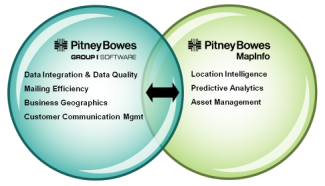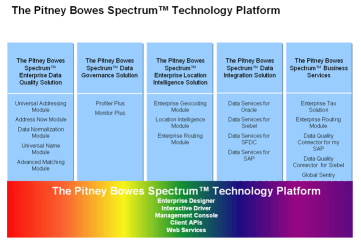 Pitney Bowes Business Insight
Pitney Bowes Business Insight (PBBI) presented to BBBT by
Joe Pindell,
Solution Evangelist. The PBBI division was recently formed from the merger of Group 1 Software (which acquired the old Sagent Technology in 2003) and MapInfo, as shown in figure. The division, in of itself, is a large software company with a 25 year history, 1,700 employees, annual revenue around $500M, and international presence in 60 countries directly and through hundreds of partners. The parent company sees PBBI as its "strategic growth component".

From their literature, PBBT offers solutions that "combines location and communications
intelligence to offer leading customer and operational management solutions
that help organizations more efficiently identify, find and market to
customers" as stated in their overview.
Their solution locate customers, enhance with additional data about trends,etc.It is a combination of location intelligence, operational intelligence, predictive analytics, and communication management. The emphasis is definitely on the location intelligence piece. As Pindell said, "Tag line is... Locate, Connect, Communicate", which is good beginning of a strategic message!
My Take... There is no doubt that PBBI is a major player, especially in the location intelligence segment, as an infrastructure component supplier. They are not known as a solution vendor, although they have a strong presence in specific industries, like insurance. However, this presence is particularly due to their large partner network.

I am concerned that PBBI may not have a long-term sustainable business model that inherently fosters innovation that will address future markets. In particular, PBBI needs to maintain and expand their leadership position in location intelligence. On their website, there are 163
product data sheets, along with many more
products listed. Missing is an unifying architecture that conveys the sense of long-term product planning.
Pindell's last slide described the Spectrum Technology Platform, formerly called
Customer Data Quality Platform. Funny...searching their website for "Spectrum" retrieved no current material. This diagram is definitely the right direction to evolve... a unifying framework for their location intelligence.
I am impressive with their potential. They have deep resources and quality people. They realize the need for vision and direction. Now, they need fixed this problem and drive the thought leader in location intelligence.